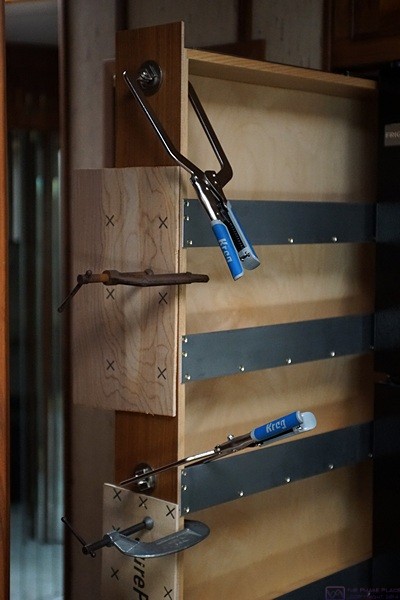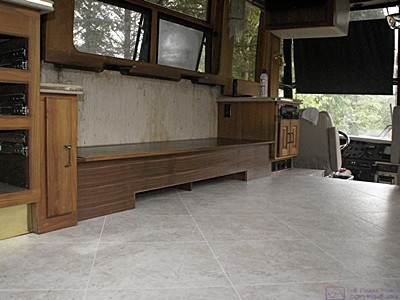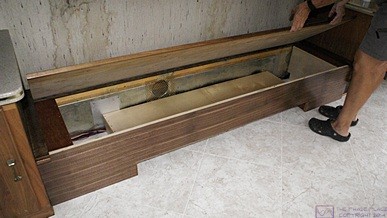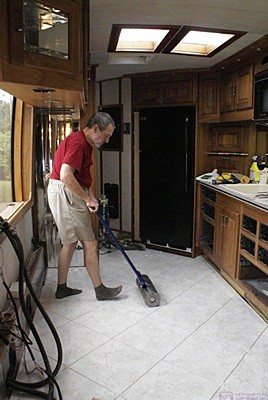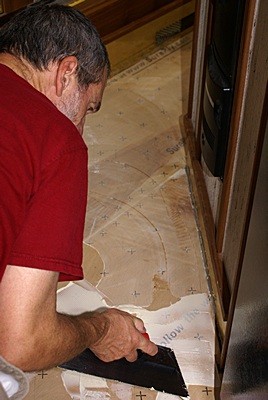Linda set her iPad alarm for 5:45 AM. I heard it go off and got up shortly thereafter even though I did not turn out my light last night until 12:30 AM. She got up at 6 AM and was showered, dressed, and out the door by 6:20.
I tuned in Weather Nation on WILX TV out of Lansing while I folded the clean laundry. Of all the stations we can pick up this is the only one with a dedicated weather sub-channel. The current forecast was for two more days with high temperatures near 60 degrees F but high humidity and rain as moisture races north from the Gulf in advance of a cold front. By the weekend we are looking at highs at or barely above freezing and lows in the low 20’s. The 10-day forecast has us back in the 40’s by Tuesday so we should not have any weather difficulties for Thanksgiving and the following day when we head south.
We planned to re-install the two front seats in the bus late this afternoon and I plan to take it on a fueling run tomorrow so I can run the Aqua-Hot diesel-fired hydronic heating system instead of running electric heaters. I will also drain and refill the fresh water tank, but those are tomorrow’s tasks. I had other things to do today, starting with the laundry.
I needed to wait until late morning to do the final cleaning of the tile in the cockpit and had several things to do that had to wait for the cleaning to be done first. To make good use of my time I decided to measure, cut, drill, and paint the 1/2″x3/4″ aluminum angle that will serve as a retaining bracket for the refrigerator. I will install it tomorrow after the front seats are re-installed and out of the way.
With that done I got the 3/4″ piece of walnut that Jarel cut and shaped for me to cover the front edges of the plywood under the refrigerator. The piece sticks up a little above the top of the top layer of plywood so I wanted to install it in a way that will allow it to be easily removed. That precluded the use of nails, even small ones. I did not want the appearance of screw heads and wasn’t interested in drilling deep countersunk holes and using plugs. (The woodwork in the bus was essentially assembled this way and most of the plugs have come out. We will probably put them all back in once we are done reconditioning the wood even though I would rather not.) That left Velcro as the only reasonable option, so I started a shopping list.
My next mini-project was to attach the 1/4″ walnut veneer plywood to the face of the pull-out pantry. Jarel had ripped two pieces to the proper width for me but neither one was quite long enough to fully cover the front of the pull-out pantry. Step 1 was figuring out where to have the two pieces meet and then determine how long each piece needed to be. The next problem to solve was how to attach them. I decided to use glue, clamp the walnut panels to the front of the pantry, and then secure them using screws from behind. I looked for my large wood clamps but could not find them so I added face clamps to my shopping list.
The front structure of the pantry is 1/2″ thick ash and I planned to drill countersunk holes from the inside so the screw heads would be flush. That meant I needed #6 5/8″ screws, which I did not have, as 3/4″ screws would probably puncture the veneer. I added the screws to my shopping list. I selected a small drill bit and drilled holes from the inside just below the top board and just below each shelf plus one just above the bottom shelf. Because of the metal side plates these locations were easier to reach on the inside. I then switched to my countersink bit and drilled the holes out from the inside.
Back in the garage I sprayed a second coat of black paint on the aluminum angles for the refrigerator retaining bracket, moved a load of laundry to the dryer and put another load in the washer, and then took my shopping list and went to Lowe’s. Lowe’s had a very clever Automax self-adjusting face clamp with a 6″ reach. It was a little pricier than the 3″ version which was a little pricier than the 3″ manual adjust version, but the size and auto adjustment feature swayed my decision.
On the drive back to house I had a nice QSO with Steve (N8AR) on the South Lyon 2m repeater. When I got home I had some wasabi/soy almonds and sourdough pretzel nibblers with hummus for lunch.
Returning to the bus work I cleaned the tile in the cockpit using Armstrong Once ‘n Done and rinsed it with a clean sponge and warm water. I then returned to working on attaching the walnut veneered plywood to the face of the pantry. I decided which piece to use for the longer bottom section and which portion of the other piece to use for the top section. In the shop I clamped each piece in turn to a 2×4, set the Boca saw guide, and trimmed them to length.
Back in the bus I applied the bottom piece first. It was slightly curled, lengthwise, so after applying Titebond II glue to the back I positioned it using the two Automax face clamps and then used C-clamps with scrap pieces of underlayment to hold it flat while protecting the veneer. I then installed #6 5/8″ SR screws from the back to secure the face plywood. I installed the upper panel using the same procedure.
We are using the same handle for the pantry that we have used throughout the bus. Jarel made a 4-1/2″ by 8″ piece of 3/4″ walnut with coved edges to serve as a decorative base for the handle and to cover the joint between the upper and lower pieces of veneered plywood. I marked the vertical centerline on the back and then marked two holes on 3″ centers, centered vertically. I selected a 1/8″ drill bit, which was slightly larger in diameter than the #8-32 machine screws used to secure the handle, and drilled the holes from the back side using a block of 2×4 as a drill guide to make sure I went straight through the board. (A drill press would obviously have been the correct way to drill these holes, and I have one, but it is buried behind other things where I cannot get to it.)
I clamped the decorative base to the front of the pantry centered horizontally and vertically on the joint between the two veneered panels. Using the handle mounting holes I drilled all the way through the front of the pantry. I bought special handle mounting screws the other night that are 2″ long but can be broken off at 1/4″ intervals. I needed a 1-3/4″ length, so I inserted the screws through the holes from the back and broke off the first section with a pair of pliers. I screwed them into the handle, temporarily securing the block. I then drilled four countersunk holes from the inside of the pantry into the back of the decorative block and secured it with 1-1/4″ self-drilling screws. I left all of the other clamps in place while the glue dried.
The only thing I did not get done on the pull-out pantry was attaching the door stop to the bottom of the face. I will take care of that tomorrow.
Linda called at 3:30 PM to let me know she was on her way home. I started working on remounting the accelerator pedal. I got the pieces of old tile that were installed in that area and used them as templates to mark the location of the mounting holes.
Yesterday I discovered a grease fitting on the steering column. It is located towards the center front of the bus about 8″ up from the floor. Joe has never put grease in this fitting when he has serviced the chassis and for all I know it may not have been greased since it left the factory. I wanted to get some grease into this fitting before I remounted the steering column shroud but I did not have a grease gun so I put that on my next shopping list.
Linda got home a little quicker than usual due to lighter than normal traffic. After changing into her work clothes and grabbing some pretzels for a snack she came out to the bus to help. I set the accelerator pedal upside down on top of the brake pedal to get it out of the way and drilled holes at the three points I had marked. Linda handled the vacuum cleaner as we are trying to keep the coach clean. I set the accelerator pedal where it belonged and started the three lag screws by hand. Linda then held the pedal up while I tightened the three screws with a socket and ratchet. I also drilled a small hole for a screw to secure the cable clamp on the accelerator wiring harness and installed that by hand as there was no room for the Rigid drill/driver.
I did not want to install the steering column shroud until I had greased the fitting but I went ahead and installed the base bracket. Again using an old tile as a template I lightly marked two of the five holes. I removed the old tile, set the bracket in place, and lined it up with the two marks. I then marked the other three holes. I selected a suitable drill bit, smaller than the diameter of the screws, and drilled through the tile and a little ways into the plywood below. The screws were 5/8″ pan head Philips so I installed them by hand.
It was finally time to install the two front seats. We got the base/pedestals from the library and checked to make sure the paint was dry. It was, so we moved them to the bus. I was going to install the driver’s seat first but the 3/4″ holes I had drilled in the tile when I installed it were not big enough. Actually, they were exactly the right size if they had been in exactly the right place. I needed to enlarge them to 1″ but did not have a 1″ drill bit. I added that to my shopping list and we proceeded to install the passenger seat.
I set the base over the four captive mounting bolts and put a large/thick washer over each one followed by a substantial lock washer and finally a nut. I ran the nuts down by hand as far as I could and then used a socket and ratchet to snug them down.
By now it was half past dark. We needed dinner and stuff for the bus so we headed to Lowe’s where I bought a 1″ twist drill with a 1/2″ shank. We then went to the new Panera, on the same property as Lowe’s and Walmart, for dinner. This Panera had a different look and feel than the older ones, which a much smaller bakery section, but the food and coffee were the same and were good. After dinner I drove across the street to O’Reilly’s Auto Parts and bought a grease gun.
On the drive home I decided to defer greasing the steering column until tomorrow. Our priority was getting the driver’s seat installed. I used the 1″ twist drill bit in our 1/2″ Craftsman drill to enlarge the four holes. The base/pedestal has 1″ long alignment tubes on the underside so the holes in the tile and underlying plywood had to be big enough to allow for less than perfect positioning. With the holes enlarged I dropped the base in place, set a large washer over each hole, and threaded the new bolts into holes in the structure of the bus. That was the end of the bus work for today. We retired to the basement recreation room and watched NCIS and NCISNOLA before going to bed.
